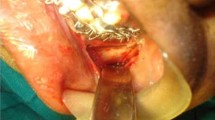Abstract
Purpose
To evaluate the results of management of mandibular angle fracture by open reduction and internal fixation using single non compression miniplate via transbuccal, intraoral or extraoral approaches.
Patients and Methods
In this prospective study, 30 patients were randomly selected regardless of age, sex requiring open reduction and internal fixation of non comminuted angle fracture with/or without other associated fractures of the mandible. All the patients were operated under general anaesthesia following routine haematological, biochemical, general physical examination and routine radiographic examination. Patients were randomly distributed into 3 groups namely: (1) intraoral, (2) transbuccal, and (3) extraoral groups depending on the surgical approach used for open reduction and internal fixation of fracture of the angle of mandible. In the intraoral group (12 patients), angle fracture was approached through the intraoral vestibular incision similar to sagittal split incision. In the transbuccal group (8 patients), angle fracture was approached through the intraoral vestibular incision and transbuccal stab incision for screw fixation via trochar. In the extraoral group (10 patients), angle fracture was approached through the Risdon’s submandibular incision. In all the patients, fractures were reduced with upper and lower Erich’s arch bar fixation as means for IMF intraoperatively. In all the patients, fracture of the angle of the mandible was fixed with single non compression 2.5 mm, 4 holed with gap stainless steel miniplate and 6/8 mm monocortical screws. All patients were followed up for minimum of 6 months to maximum of 24 months.
Results
Complications were relatively minor such as paresthesia (on average 26.7 % first post-operative day which was gradually improved and on average after 1 month was 3.3 %), mild to moderate occlusal discrepancies (on average 36.7 %) which needed the post-operative intermaxillary fixation with elastics for 1–2 weeks, infection (20 % on average) was mild to moderate which was managed with antibiotic therapy and/or incision and drainage except in one case, plate removal was done under general anaesthesia (extraoral group) because of recurrent infection. Post-operative pain was mild to moderate (mean VAS score pre operative–6.17, post-operative 1 week–1.63) which was managed with analgesics. Mouth opening was recorded in all patients which was on average 20.98 mm preoperatively which improved to 40.57 mm after 1 month.
Conclusion
The use of a single non compression miniplate for fractures of the angle of the mandible is a simple, reliable technique with relatively rare major complications and few minor complications irrespective of the surgical approach used for the open reduction.



Similar content being viewed by others
References
Halmos DR, Ellis E III, Dodson TB (2004) Mandibular third molars, angle fractures. J Oral Maxillofac Surg 62:1076–1081
Fusaelier JC, Ellis EE, Dadson TB (2002) Do mandibular third molars alter the risk of angle fracture? J Oral Maxillofac Surg 60:514–518
Ellis E III (1999) Treatment methods for fractures of the mandibular angle. Int J Oral Maxillofac Surg 28:243–252
Gear AJL, Apasova E, Schmitz JP, Shubert W (2005) Treatment modalities for mandibular angle fractures. J Oral Maxillofac Surg 63:655–663
Ellis E III, Walker L (1994) Treatment of mandibular angle fracture using two non compression miniplates. J Oral Maxillofac Surg 52:1032–1036
Ellis E III, Walker LR (1996) Treatment of mandibular angle fracture using one non compression miniplate. J Oral Maxillofac Surg 54:864–871
Nishioka GJ, Van Sickels JE (1988) A transoral plating of mandibular angle fractures: a technique. J Oral Surg 66:531–535
Valentino J, Levy FE, Marentette LJ (1994) Intraoral monocortical miniplating of mandible fractures. Arch Otolaryngol Head Neck Surg 120:605–612
Wagner WF, Neal DC, Alpert B (1979) Morbidity associated with extraoral open reduction of mandibular fractures. J Oral Surg 37:97–100
Acknowledgments
The authors thank the Department of OMFS staff and the hospital staff of J.S.S Medical College & Hospital, Mysore.
Author information
Authors and Affiliations
Corresponding author
Rights and permissions
About this article
Cite this article
Pattar, P., Shetty, S. & Degala, S. A Prospective Study on Management of Mandibular Angle Fracture. J. Maxillofac. Oral Surg. 13, 592–598 (2014). https://doi.org/10.1007/s12663-013-0542-3
Received:
Accepted:
Published:
Issue Date:
DOI: https://doi.org/10.1007/s12663-013-0542-3




